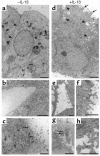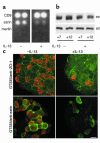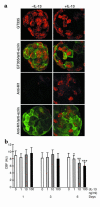IL-13 alters mucociliary differentiation and ciliary beating of human respiratory epithelial cells
- PMID: 11748265
- PMCID: PMC209466
- DOI: 10.1172/JCI13557
IL-13 alters mucociliary differentiation and ciliary beating of human respiratory epithelial cells
Abstract
In animal models of asthma, interleukin-13 (IL-13) induces goblet cell metaplasia, eosinophil infiltration of the bronchial mucosa, and bronchial hyperreactivity, but the basis of its effects on airway epithelia remain unknown. Lesions of the epithelial barrier, frequently observed in asthma and other chronic lung inflammatory diseases, are repaired through proliferation, migration, and differentiation of epithelial cells. An inflammatory process may then, therefore, influence epithelial regeneration. We have thus investigated the effect of IL-13 on mucociliary differentiation of human nasal epithelial cells in primary culture. We show that IL-13 alters ciliated cell differentiation and increases the proportion of secretory cells. IL-13 downregulates the actin-binding protein ezrin and other cytoskeletal components. IL-13 also impairs lateral cell contacts and interferes with the apical localization of ezrin seen in differentiated ciliated cells. In addition, an IL-4 antagonistic mutant protein (Y124D), which binds to the IL-4 receptor alpha subunit, a common chain of IL-4 and IL-13 receptors, inhibits IL-13's effects. IL-13 also decreases ciliary beat frequency in a time- and dose-dependent manner. These results suggest that, in human allergic asthmatic responses, IL-13 affects both ciliated and secretory cell differentiation, leading to airway damage and obstruction.
Figures





Similar articles
-
Interleukin-13 interferes with CFTR and AQP5 expression and localization during human airway epithelial cell differentiation.Exp Cell Res. 2007 Jul 15;313(12):2695-702. doi: 10.1016/j.yexcr.2007.02.035. Epub 2007 Mar 21. Exp Cell Res. 2007. PMID: 17553491
-
Interleukin-9 induces goblet cell hyperplasia during repair of human airway epithelia.Am J Respir Cell Mol Biol. 2003 Mar;28(3):286-95. doi: 10.1165/rcmb.4887. Am J Respir Cell Mol Biol. 2003. PMID: 12594054
-
Secretory phospholipases A2 are secreted from ciliated cells and increase mucin and eicosanoid secretion from goblet cells.Chest. 2015 Jun;147(6):1599-1609. doi: 10.1378/chest.14-0258. Chest. 2015. PMID: 25429648 Free PMC article.
-
Interleukin-13 alters mucociliary differentiation of human nasal epithelial cells.Chest. 2003 Mar;123(3 Suppl):373S-4S. doi: 10.1378/chest.123.3_suppl.373s. Chest. 2003. PMID: 12628987 Review. No abstract available.
-
Regulation of differentiation of the tracheobronchial epithelium.J Aerosol Med. 2000 Fall;13(3):207-18. doi: 10.1089/jam.2000.13.207. J Aerosol Med. 2000. PMID: 11066024 Review.
Cited by
-
Cross-talk of inflammatory mediators and airway epithelium reveals the cystic fibrosis transmembrane conductance regulator as a major target.ERJ Open Res. 2021 Dec 13;7(4):00247-2021. doi: 10.1183/23120541.00247-2021. eCollection 2021 Oct. ERJ Open Res. 2021. PMID: 34912883 Free PMC article.
-
T helper 2 cells in asthma.J Exp Med. 2023 Jun 5;220(6):e20221094. doi: 10.1084/jem.20221094. Epub 2023 May 10. J Exp Med. 2023. PMID: 37163370 Free PMC article. Review.
-
AAV-mediated MUC5AC siRNA delivery to prevent mucociliary dysfunction in asthma.bioRxiv [Preprint]. 2025 Mar 14:2025.03.12.642720. doi: 10.1101/2025.03.12.642720. bioRxiv. 2025. PMID: 40161599 Free PMC article. Preprint.
-
Assessing susceptibility for polycyclic aromatic hydrocarbon toxicity in an in vitro 3D respiratory model for asthma.Front Toxicol. 2024 Apr 19;6:1287863. doi: 10.3389/ftox.2024.1287863. eCollection 2024. Front Toxicol. 2024. PMID: 38706568 Free PMC article.
-
Mucus Structure, Viscoelastic Properties, and Composition in Chronic Respiratory Diseases.Int J Mol Sci. 2024 Feb 5;25(3):1933. doi: 10.3390/ijms25031933. Int J Mol Sci. 2024. PMID: 38339210 Free PMC article. Review.
References
-
- Van der Velden VHJ, Savelkoul HFJ, Versnel MA. Bronchial epithelium: morphology, function, and pathophysiology in asthma. Eur Cytokine Netw. 1998;9:585–597. - PubMed
-
- Corry DB. IL-13 in allergy: home at last. Curr Opin Immunol. 1999;11:610–614. - PubMed
-
- Loots GG, et al. Identification of a coordinate regulator of interleukins 4, 13, and 5 by cross-species sequence comparisons. Science. 2000;288:136–140. - PubMed
-
- Hancock A, Armstrong L, Gama R, Millar A. Production of interleukin 13 by alveolar macrophages from normal and fibrotic lung. Am J Respir Cell Mol Biol. 1998;18:60–65. - PubMed
-
- Minty A, et al. Interleukin-13 is a new human lymphokine regulating inflammatory and immune responses. Nature. 1993;362:248–250. - PubMed
Publication types
MeSH terms
Substances
LinkOut - more resources
Full Text Sources
Other Literature Sources
Medical
Miscellaneous

